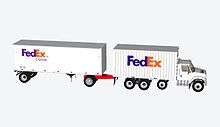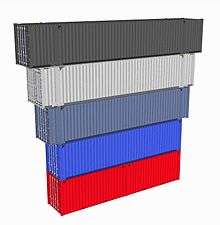Long Combination Vehicle






Long combination vehicles[1] are combinations of multiple Trailers on tractor trucks as compared to standard 5 axle semi trailer-trucks with one trailer. Combinations of LCVs are:
- Turnpike double - two 40 ft trailers or longer up to 53 footers

- Rocky Mountain doubles - one 40 ft trailer or longer and another shorter trailer usually a 28-foot (pup)

- Triple trailer - three 28.5 ft pups
.jpg)
- B-Train - 33 foot max twin trailer that shares a tridem wheel set between the front and back trailer.

- STAA doubles pups - two 28.5 ft trailers

LCVs are useful because they usually carry extra freight in terms of square and cubic feet capacity as well as weight capacity; because of the extra axles it spreads out the weight across a longer area. They're also more efficient based on Ton-mileage.
In the United States some states allow certain combinations on certain routes. In the western United States LCVs are allowed on many Interstate highways. The only LCVs allowed nationwide are STAA doubles.[2]

MAP-21 transportation bill
Future combinations are under study and consideration to be allowed on the National Network. These new standards were scheduled to be released in November 2014.

Federal Bridge Weight Formula
| Distance in feet between any group of two or more axles 1 |
Gross weight in pounds 2 | |||||
|---|---|---|---|---|---|---|
| 2 axles | 3 axles | 4 axles | 5 axles | 6 axles | 7 axles | |
| Less than 8 3 | 34,000 | 34,000 | ||||
| More than 8 4 | 38,000 | 42,000 | ||||
| 9 | 39,000 | 42,500 | ||||
| 10 | 40,0005 | 43,500 | ||||
| 11 | 40,000 | 44,000 | ||||
| 12 | 40,000 | 45,000 | 50,000 | |||
| 13 | 40,000 | 45,000 | 50,500 | |||
| 14 | 40,000 | 46,500 | 51,500 | |||
| 15 | 40,000 | 47,000 | 52,000 | |||
| 16 | 40,000 | 48,000 | 52,500 | 58,000 | ||
| 17 | 40,000 | 48,500 | 53,500 | 58,500 | ||
| 18 | 40,000 | 49,500 | 54,000 | 59,000 | ||
| 19 | 40,000 | 50,500 | 54,500 | 60,000 | ||
| 20 | 40,000 | 51,000 | 55,500 | 60,500 | 66,000 | |
| 21 | 40,000 | 51,500 | 56,000 | 61,000 | 66,500 | |
| 22 | 40,000 | 52,500 | 56,500 | 61,500 | 67,000 | |
| 23 | 40,000 | 53,000 | 57,500 | 62,500 | 68,000 | |
| 24 | 40,000 | 54,000 | 58,000 | 63,000 | 68,500 | 74,000 |
| 25 | 40,000 | 54,500 | 58,500 | 63,500 | 69,000 | 74,500 |
| 26 | 40,000 | 55,500 | 59,500 | 64,000 | 69,500 | 75,000 |
| 27 | 40,000 | 56,000 | 60,000 | 65,000 | 70,000 | 75,500 |
| 28 | 40,000 | 57,000 | 60,500 | 65,500 | 71,000 | 76,500 |
| 29 | 40,000 | 57,500 | 61,500 | 66,000 | 71,500 | 77,000 |
| 30 | 40,000 | 58,500 | 62,000 | 66,500 | 72,000 | 77,500 |
| 31 | 40,000 | 59,000 | 62,500 | 67,500 | 72,500 | 78,000 |
| 32 | 40,000 | 60,0005 | 63,500 | 68,000 | 73,000 | 78,500 |
| 33 | 40,000 | 60,000 | 64,000 | 68,500 | 74,000 | 79,000 |
| 34 | 40,000 | 60,000 | 64,500 | 69,000 | 74,500 | 80,0005 |
| 35 | 40,000 | 60,000 | 65,500 | 70,000 | 75,000 | 80,000 |
| 36 | 40,000 | 60,000 | 66,0006 | 70,500 | 75,500 | 80,000 |
| 37 | 40,000 | 60,000 | 66,5006 | 71,000 | 76,000 | 80,000 |
| 38 | 40,000 | 60,000 | 67,5006 | 71,500 | 77,000 | 80,000 |
| 39 | 40,000 | 60,000 | 68,000 | 72,500 | 77,500 | 80,000 |
| 40 | 40,000 | 60,000 | 68,500 | 73,000 | 78,000 | 80,000 |
| 41 | 40,000 | 60,000 | 69,500 | 73,500 | 78,500 | 80,000 |
| 42 | 40,000 | 60,000 | 70,000 | 74,000 | 79,000 | 80,000 |
| 43 | 40,000 | 60,000 | 70,500 | 75,000 | 80,0005 | 80,000 |
| 44 | 40,000 | 60,000 | 71,500 | 75,500 | 80,000 | 80,000 |
| 45 | 40,000 | 60,000 | 72,000 | 76,000 | 80,000 | 80,000 |
| 46 | 40,000 | 60,000 | 72,500 | 76,500 | 80,000 | 80,000 |
| 47 | 40,000 | 60,000 | 73,500 | 77,500 | 80,000 | 80,000 |
| 48 | 40,000 | 60,000 | 74,000 | 78,000 | 80,000 | 80,000 |
| 49 | 40,000 | 60,000 | 74,500 | 78,500 | 80,000 | 80,000 |
| 50 | 40,000 | 60,000 | 75,500 | 79,000 | 80,000 | 80,000 |
| 51 | 40,000 | 60,000 | 76,000 | 80,0005 | 80,000 | 80,000 |
| 52 | 40,000 | 60,000 | 76,500 | 80,000 | 80,000 | 80,000 |
| 53 | 40,000 | 60,000 | 77,500 | 80,000 | 80,000 | 80,000 |
| 54 | 40,000 | 60,000 | 78,000 | 80,000 | 80,000 | 80,000 |
| 55 | 40,000 | 60,000 | 78,500 | 80,000 | 80,000 | 80,000 |
| 56 | 40,000 | 60,000 | 79,500 | 80,000 | 80,000 | 80,000 |
| 57 | 40,000 | 60,000 | 80,0005 | 80,000 | 80,000 | 80,000 |
- 1 Calculated values reflect FHWA policy of rounding down when distances fall exactly between 6-inch (15 cm) increments.[3]
- 2 Calculated values reflect FHWA policy of rounding down when weights fall exactly between 500 pound increments.[4]
- 3 Tandem axle by definition.[5]
- 4 Distances between 8 feet (2.4 m) to 8 feet 11 inches (2.72 m) may not be rounded down.[3]
- 5 __ Maximum legal weight limit based on number of axles. Increased axle lengths beyond these do not increase maximum legal weight.[5]
- 6 __ Exception to the formula: when the four axles under consideration are two tandem axles spaced at least 36 feet (11 m) apart, a gross weight of 68,000 pounds (31,000 kg) is allowed.[5]
- __ Upper blank areas represent unrealistic configurations.[4]
Container transport


ISO containers come in 5 standard sizes 20's, 40's, 45's, 48's, and 53 footers. They can be stacked, provided that the anchor points line up - for example a 40 ft container on top of two 20 ft containers placed in line. 2 x 20 ft containers can NOT be stacked on a 40 foot as the centers would not be supported.
Container Ships
Container ships only take 20's, 40's and also 45's above deck. 90% of the containers on container ships are 40 footers.
_002.jpg)
Trains
Intermodal container trains in America come in 2 varieties foreign and domestic container trains.
Domestic
Domestic intermodal trains Carry 53 footers plus Trailer-on-flatcar and they travel throughout North America
Foreign
Foreign intermodal trains carry 20's, 40's, and 45's to and from Container ports to import or export intercontinentally.
Container Carriers
Americas largest container carriers JB Hunt, Schneider National, and Swift don't own a single 40', 45', or 20' foot container making intercontinental shipping through them impossible. All the 40' shipping container companies are foreign like Maersk, MSC, or CMA CGM or they are container leasing companies in America like Textainer or Triton and none of these carriers network out American exports well. Intercontinental container shipping is Full container load shipping and that's in contrast to less than trailer load shipping.
See also
- Federal Bridge Weight Formula
- Semi-trailer truck
- Dolly (trailer)
- Intermodal freight transport
- Longer Heavier Vehicle
- Road train
- Containerization
- Shipping container
- Container ship
- Container on barge
- National Network - highway and interstate system
- Top intermodal container companies list
References
- ↑ https://www.testquestionsandanswers.com/cdl/combination-vehicles-test.html
- ↑ https://www.fhwa.dot.gov/reports/tswstudy/Vol3-Chapter3.pdf
- 1 2 "Questions and Answers about Vehicle Size and Weight". Federal Highway Administration. Archived from the original on March 15, 2008. Retrieved March 27, 2008.
- 1 2 "Bridge Formula Weights Calculator". Federal Highway Administration. Retrieved February 3, 2008.
- 1 2 3
- Combination Vehicles for Commercial Drivers License
- http://www.epa.gov/smartway/forpartners/documents/trucks/techsheets-truck/EPA420F10-053.pdf